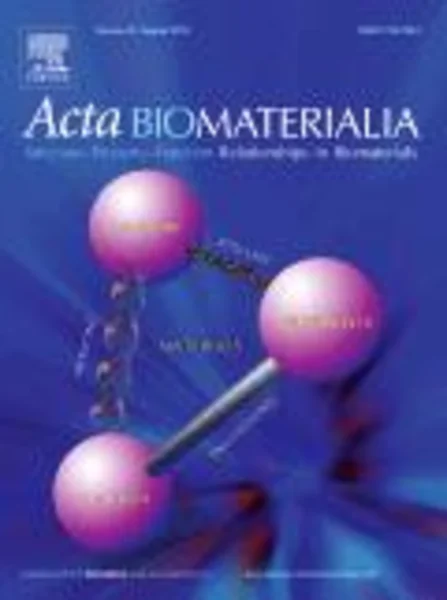-
trace element-incorporating octacalcium phosphate porous beads via polypeptide-assisted nanocrystal self-assembly for potential applications in osteogenesis
جزئیات بیشتر مقاله- تاریخ ارائه: 1392/01/01
- تاریخ انتشار در تی پی بین: 1392/01/01
- تعداد بازدید: 723
- تعداد پرسش و پاسخ ها: 0
- شماره تماس دبیرخانه رویداد: -
the promising future of calcium phosphates (cap) as a group of biomedical materials with a wide range of functions, might ultimately depend on tuning their composition and microstructure. however, the disorderly growth and aggregation of cap nanocrystals limit their practical application. this paper reports a strategy for designing polypeptide/trace elements (te), dual mediating the self-assembly of octacalcium phosphate (ocp) nanocrystals, with multilayered porous cross section and te dilute doping. intriguing advantages such as bead morphology, mesoporous structure, tunable diameter (20–1000 μm) and te contents, biodegradability and bioactivity are obtained. the microcomputerized-tomography reconstruction reveals an interconnective macroporous architecture and a void volume of over 49.02% for the nearly close-packed bead scaffolds. the specific surface area and average mesopore size are 89.73 m2 g−1and 2.75 nm for the 180 μm diameter bead group, and those of 500 μm diameter beads are 130.17 m2 g−1 and 3.69 nm, respectively. it is demonstrated that the bead production mechanism is a multistep process including liquid-like precursor formation, nanocrystal nucleation and aggregation, aggregate combination and bead growth. such a multilayer structure of te–ocp porous beads would have adequate physical strength to maintain their shape, in contrast to the physical weakness of pure ocp hollow shell. the beads exhibit good biocompatibility and degradability and encourage bone mineralization in the early stage in vivo. this study demonstrates the feasibility of developing highly porous calcium phosphate giant beads via biomimetic self-assembly for direct application in reconstructive surgery and other widespread applications such as tissue engineering and drug delivery.
مقالات جدیدترین رویدادها
-
استفاده از تحلیل اهمیت-عملکرد در ارائه الگوی مدیریت خلاقیت سازمانی و ارائه راهکار جهت بهبود
-
بررسی تاثیر ارزش وجوه نقد مازاد بر ساختار سرمایه شرکت های پذیرفته شده در بورس اوراق بهادار تهران
-
بررسی تأثیر سطح افشای ریسک بر قرارداد بدهی شرکت های پذیرفته شده در بورس اوراق بهادار تهران
-
بررسی تأثیر رتبه بندی اعتباری مبتنی بر مدل امتیاز بازار نوظهور بر نقد شوندگی سهام با تأکید بر خصوصی سازی شرکت ها
-
تأثیر آمیخته بازاریابی پوشاک ایرانی بر تصویر ذهنی مشتری پوشاک ایرانی (هاکوپیان)
-
بررسی رفتار ستون های فلزی دوجداره ی پرشده با بتن در مقابل آتش
-
سنجش سطح خوانایی کتاب فارسی پایه یازدهم مقطع متوسطه دوم بر اساس تکنیک خوانایی مک لافلین
-
معرفی پارامترهای موثر جهت طراحی مناسب ترین روش استخراج ذخایر سنگ تزئینی گرانیت در جنوب نهبندان
-
بررسی نتایج موارد آسپیراسیون سونی ندول های تیروئید در کلینیک تخصصی شهر اردبیل طی سال های 81-1379
-
تفسیر محیط رسوبی سازند دلیچای در برش درجزین در شمال سمنان بر مبنای پالینومرف ها
مقالات جدیدترین ژورنال ها
-
مدیریت و بررسی افسردگی دانش آموزان دختر مقطع متوسطه دوم در دروان کرونا در شهرستان دزفول
-
مدیریت و بررسی خرد سیاسی در اندیشه ی فردوسی در ادب ایران
-
واکاوی و مدیریت توصیفی قلمدان(جاکلیدی)ضریح در موزه آستان قدس رضوی
-
بررسی تاثیر خلاقیت، دانش و انگیزه کارکنان بر پیشنهادات نوآورانه کارکنان ( مورد مطالعه: هتل های 3 و 4 ستاره استان کرمان)
-
بررسی تاثیر کیفیت سیستم های اطلاعاتی بر تصمیم گیری موفق در شرکتهای تولیدی استان اصفهان (مورد مطالعه: مدیران شرکتهای تولیدی استان اصفهان)
-
عوامل بروز فساد اداری از دیدگاه اسلام
-
بررسی تاثیر موتاژن شیمیایی اتیل متان سولفونات (ems) بر صفات جوانه زنی بذر لیسیانتوس
-
بررسی جزایی ابعاد و ارکان جرم کلاه برداری رایانه ای
-
an analogue experiment on pervious concrete subject to dust fall blocking
-
the impacts of urban morphology on housing indoor thermal condition in hoi an city, vietnam




سوال خود را در مورد این مقاله مطرح نمایید :